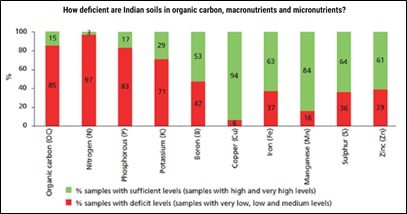

7th May 2022 (7 Topics)
Context
According to a report released by the Centre for Science and Environment (CSE), most Indian soils are deficient in organic carbon and macronutrients.
About
Key highlights of report:
- About 85 per cent of the samples were found to be deficient in organic carbon; 97 per cent samples were deficient in available nitrogen; 83 per cent were deficient in phosphorus; and 71 per cent in potassium.
- Soils were deficient in micronutrients as well: About 47 per cent, 39 per cent, 37 per cent and 36 per cent soil samples were deficient in boron, zinc, iron and sulphur
- At least half of the soil samples in 24 states and Union territories were deficient in organic carbon.
- Of them, seven states have more than 90 per cent deficient samples.
- Haryana’s soils are the most deficient in organic carbon, followed by those of Punjab, Uttar Pradesh, Rajasthan, Tamil Nadu, Mizoram and Andaman and Nicobar Islands, in that order.
- As many as 27 states and UTs recorded nitrogen deficiency in over 90 per cent samples.
- 15 states had nitrogen deficiency in almost all (99-100 per cent) of their samples.

- 15 states had nitrogen deficiency in almost all (99-100 per cent) of their samples.
- In 2019, India was the second highest producer and consumer of chemical fertilizers in the world.
- Chemical fertilizer consumption: In 2020–21, the chemical fertilizer consumption in India, excluding single super phosphate (SSP), was 62.98 million tonne, with a growth of more than 82.5 per cent since 2000–01.
- Carrier-based solid bio-fertilizers: In 2020–21, India produced about 1,34,323 tonne of carrier-based solid bio-fertilizers.
- Liquid bio-fertilizers: In 2020–21, the total production of liquid bio-fertilizers in India was about 26,442 kilolitre (kl). This marked a growth of about 552 per cent over the 2014–15 figures.
Importance of fertilization for nutrient replenishment in soil:
- Crops extract nutrients from soil. Replenishment of nutrients is crucial if crop production is to continue in the long run.
- Soil replenishment can be done through several ways, for example, by recycling organic matter or biomass in soil or through practices that help regain and rejuvenate soil nutrients or by application of external fertilizers.
- Recycling of organic matter or biomass can be done through application of organic fertilizers and practices like growing green manure crops or mulching.
- Some other practices that help regain nutrients include crop rotation, inter-cropping and mixed cropping.
- Biofertilizers can enable nutrient mobilization and solubilization in soil. Chemical-based fertilizers directly provide nutrients to the soil.
|
About Centre for Science and Environment (CSE):
|
More Articles

